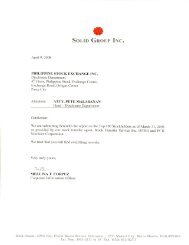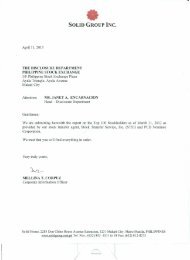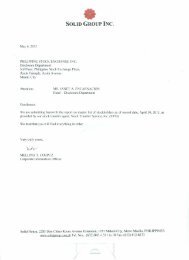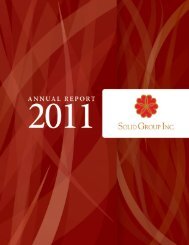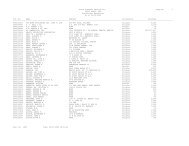SEC Form 17-A: Annual Report - the solid group inc website
SEC Form 17-A: Annual Report - the solid group inc website
SEC Form 17-A: Annual Report - the solid group inc website
You also want an ePaper? Increase the reach of your titles
YUMPU automatically turns print PDFs into web optimized ePapers that Google loves.
- 19 -<br />
If <strong>the</strong> business combination is achieved in stages, <strong>the</strong> acquirer is required to remeasure<br />
its previously held equity interest in <strong>the</strong> acquiree at its acquisition-date fair value and<br />
recognize <strong>the</strong> resulting gain or loss, if any, in <strong>the</strong> profit or loss or o<strong>the</strong>r comprehensive<br />
<strong>inc</strong>ome, as appropriate.<br />
Any contingent consideration to be transferred by <strong>the</strong> Group is recognized at fair value<br />
at <strong>the</strong> acquisition date. Subsequent changes to <strong>the</strong> fair value of <strong>the</strong> contingent<br />
consideration that is deemed to be an asset or liability is recognized in accordance with<br />
PAS 37 ei<strong>the</strong>r in profit or loss or as a change to o<strong>the</strong>r comprehensive <strong>inc</strong>ome.<br />
Contingent consideration that is classified as equity is not remeasured, and its<br />
subsequent settlement is accounted for within equity.<br />
2.14 Provisions and Contingencies<br />
Provisions are recognized when present obligations will probably lead to an outflow of<br />
economic resources and <strong>the</strong>y can be estimated reliably even if <strong>the</strong> timing or amount of<br />
<strong>the</strong> outflow may still be uncertain. A present obligation arises from <strong>the</strong> presence of a<br />
legal or constructive obligation that has resulted from past events.<br />
Provisions are measured at <strong>the</strong> estimated expenditure required to settle <strong>the</strong> present<br />
obligation, based on <strong>the</strong> most reliable evidence available at <strong>the</strong> end of <strong>the</strong> reporting<br />
period, <strong>inc</strong>luding <strong>the</strong> risks and uncertainties associated with <strong>the</strong> present obligation.<br />
Where <strong>the</strong>re are a number of similar obligations, <strong>the</strong> likelihood that an outflow will be<br />
required in settlement is determined by considering <strong>the</strong> class of obligations as a whole.<br />
When time value of money is material, long-term provisions are discounted to <strong>the</strong>ir<br />
present values using a pretax rate that reflects market assessments and <strong>the</strong> risks specific<br />
to <strong>the</strong> obligation. The <strong>inc</strong>rease in <strong>the</strong> provision due to passage of time is recognized as<br />
interest expense. Provisions are reviewed at <strong>the</strong> end of each reporting period and<br />
adjusted to reflect <strong>the</strong> current best estimate.<br />
In those cases where <strong>the</strong> possible outflow of economic resource as a result of present<br />
obligations is considered improbable or remote, or <strong>the</strong> amount to be provided for<br />
cannot be measured reliably, no liability is recognized in <strong>the</strong> con<strong>solid</strong>ated financial<br />
statements. Similarly, possible inflows of economic benefits to <strong>the</strong> Group that do not<br />
yet meet <strong>the</strong> recognition criteria of an asset are considered contingent assets, hence, are<br />
not recognized in <strong>the</strong> con<strong>solid</strong>ated financial statements. On <strong>the</strong> o<strong>the</strong>r hand, any<br />
reimbursement that <strong>the</strong> Group can be virtually certain to collect from a third party with<br />
respect to <strong>the</strong> obligation is recognized as a separate asset not exceeding <strong>the</strong> amount of<br />
<strong>the</strong> related provision.<br />
2.15 Revenue and Expense Recognition<br />
Revenue comprises revenue from <strong>the</strong> sale of goods and <strong>the</strong> rendering of services<br />
measured by reference to <strong>the</strong> fair value of consideration received or receivable by <strong>the</strong><br />
Group for goods sold and services rendered, excluding VAT and trade discounts.



